- Home
- Resources
- Safe work procedures
- Preparing and painting corrugated asbestos cement roof and fences
Asbestos
Preparing and painting corrugated asbestos cement roof and fences
Decades ago, corrugated cement roofing sheets, more commonly called fibro or ‘Super Six’, were made with asbestos fibres to give the sheets strength and resistance to chemicals and the harsh environment.
Over time, lichen growing on the roof sheets commonly discolours them from the original light grey into a dark grey/grey black.
Unpainted Super Six roof with lichen on it
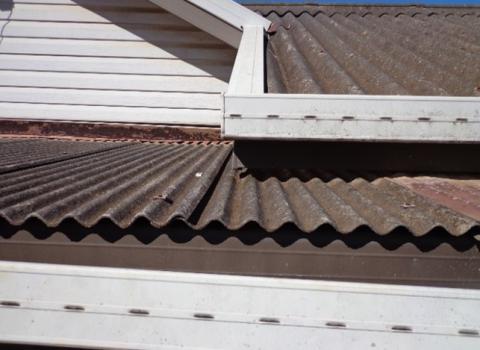
Lichen attaches itself to the smooth surface of the roof sheets, and its roots eventually damage the sheets’ integrity, creating small fractures on the surface.
A carport roof, unpainted and not maintained with moss ground in the guttering
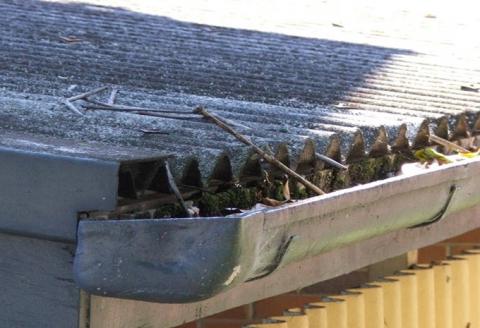
Homeowners and roof painters used to clean these roof sheets with high-pressure water blasters. This was effective, but not safe for people or the environment. It is now illegal to clean a fibro roof with high-pressure water because it destroys the surface, causing cement and asbestos dust and debris to be sprayed into the air, contaminating your property and possibly neighboring properties.
ACD (asbestos containing dust and debris) which has settled on the grass and dandelion weeds, after a roof was cleaned by a high-pressure water blaster
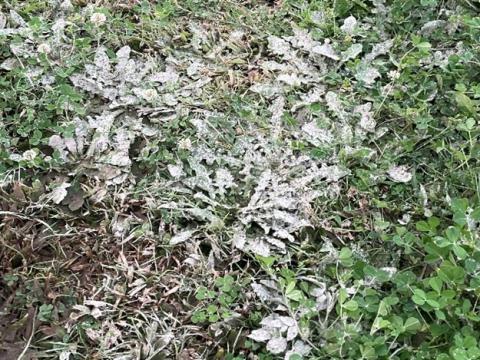
If your asbestos roof is in poor condition, consider replacing it with a roof that requires no maintenance. However, if it’s still in good condition but just needs cleaning, it’s much safer to apply a fungicide, lightly wash it down (using a garden hose with no nozzle attached, at low pressure), then paint it to seal the surface. A well-maintained asbestos roof is not a risk to you and your family’s health.
Follow the below steps to prepare and maintain your corrugated asbestos cement roof. The same can be applied for asbestos containing awnings and fences.
Risks
As well as containing and controlling the risks associated with asbestos products, you will also need to control other safety risks such as:
- working at height
- electrical risks from working near or contacting electrical cables and equipment (overhead powerlines and solar PV systems) and working in ceiling spaces
- heat stress and working in confined spaces.
Remember to always turn off the main power switches at the switchboard before going into ceiling spaces.
Equipment
Ensure you have the following equipment:
- Scaffolding, edge protection, suitable ladder etc.
- Several 200 micron (0.2mm) thick plastic bags for asbestos waste.
- Filter membrane (media filter) and filter socks fitted to each downpipe.
- Duct tape and metal tent pegs.
- Suitable ladder for roof access.
- Long garden hose (without the nozzle).
- Watering can (9L) or (5L) garden pressure sprayer.
- Packet of heavy-duty wet wipes (large size).
- Personal protective equipment (PPE) e.g. gloves, protective eye wear, coveralls, hard hat and fall arrest system.
- Respiratory protective equipment (RPE) that is fitted to your face and minimum class P2.
- 35L container (623x 423 x190mm).
- Mould control (fungicide).
- Roof primer and roof paint.
- Flow through water soft bristle brush.
Prepare the work area
- Install suitable scaffolding, edge protection and/or a fall arrest system.
- Contact your electrical distributor to install a visual aid like a tiger tail on the powerlines coming into the property.
- Disconnect stormwater down pipes from the gutters at ground level.
- Place a filter membrane under the pipe and then fit and secure a filter sock onto the down pipe above the filter membrane. Repeat this process on all downpipes.
Filter sock on downpipe with filter membrane beneath it
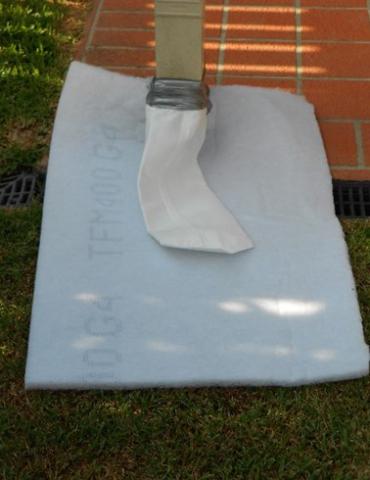
- Place and secure the access ladder to the edge of the roof.
- Place a filter membrane (media filter) under the ladder and around the immediate area (approx. 2m x 1m) and secure with tent pegs.
- Place a flat container (wash trough) directly beside the ladder. Fill the container with approx. 20mm of water and cover with two layers of filter membrane (media filter). This is to decontaminate your footwear.
Preparation and painting
Only work on a dry roof as these roofs are slippery when wet.
- Wearing roof appropriate PPE and RPE, apply mould control (fungicide) with a watering can or garden pressure sprayer.
- After the fungicide has dried, connect the flow-through water brush to the garden hose and turn the water on at low level (enough for the water to wet the brush constantly).
- Wash the whole roof and use the brush to push loose residue towards the gutters.
- Disconnect the hose from the flow-through brush. Using the hose with the water flowing, push the residue in the guttering to the downpipe until the gutters are clean. The filter membrane will capture any roof residue.
- While waiting for the roof to dry, wipe down the hose with wet wipes and place the wetted flow-through broom into an asbestos waste bag along with any wipes.
- As you leave the roof, wipe down the ladder rungs and step into the flat container (wash trough) to clean your shoes.
- Remove your gloves and RPE and place them into a waste bag.
- Prepare to apply primer paint with a brush and paint roller, not a compressor. This method does not disturb the roof sheet surface and ensures better application and adhesion.
- When the roof surface is dry, apply the primer over the whole roof. When you’ve finished, dispose of the roller and brush as asbestos waste.
- Follow the decontamination process as with the fungicide application.
- When the primer is dry, apply two coats of roof paint. You will not need to wear asbestos PPE and RPE this time because the primer is sealing the surface. However, you might need PPE for the paint itself.
- Double-bag decontaminated equipment if using on the next site.
- Double-bag asbestos waste and dispose of it correctly.
A painted Super Six roof
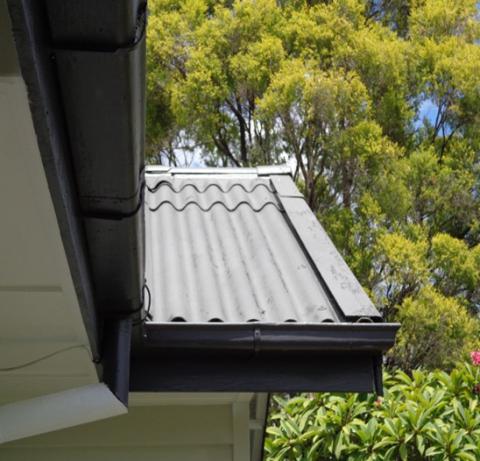
Worker wearing appropriate PPE and RPE to apply mould control on roof
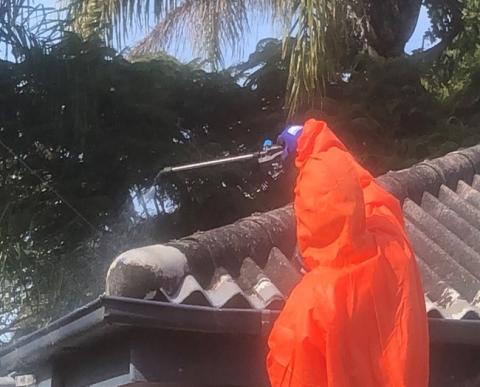
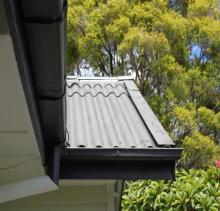
- Home
- General information
- What is asbestos?
- How was asbestos used?
- Are there health effects?
- The risks of exposure
- Health monitoring
- Legislation and codes of practice
- Low density asbestos fibre board
- Asbestos contaminated dust or debris
- Fires
- Cleaning up after floods and storms
- Importation prohibited
- Government and agency roles
- Asbestos in government assets
- Know where asbestos is
- Removing or disturbing asbestos
- Practical guidance
- Resources
- Asbestos alerts
- Asbestos news
- Codes of practice
- Guidance
- Films
- Asbestos safety session 2021
- Asbestos safety session 2020
- Cleaning Asbestos Roofs
- Shadow vacuuming with a H-Class vacuum cleaner
- Use and maintenance of a H-Class vacuum cleaner
- Identifying low density asbestos fibre board hazards and risks
- Working safely with asbestos for the home renovator
- How to properly wear personal protective equipment for airborne contaminants
- Personal protective equipment
- Dear Dad - An asbestos awareness film
- Clear and present danger: Asbestos exposed
- Uses and applications of asbestos - an extract from a film by Parsons Brinckerhoff
- Asbestos health issues - an extract from a film by Parsons Brinckerhoff
- Safe work procedure - storm and wind damage cleanup
- Drilling into asbestos walls and ceilings
- Asbestos - Removing switchboard panels
- Decontamination procedure, personal decontamination and cleanup procedures
- Asbestos awareness
- Safe work procedures
- Preparation before commencing the task
- Preparing and painting corrugated asbestos cement roof and fences
- Drilling into non-friable asbestos using a thickened substance to control airborne fibres and dust
- Drilling into non-friable ACM using an H rated industrial HEPA filter vacuum to control airborne fibres and dust
- Removing a small package electrical switchboard
- Cleanup and disposal
- Safe cleanup of storm damaged materials that may contain asbestos
- Frequently asked questions for homeowners and the general public
- Podcasts
- Strategies
- Working Safely with Asbestos Guide
- Asbestos awareness week 2025
- Asbestos management compliance campaign
- Induction and safety training for unlicensed work
- Sanctions